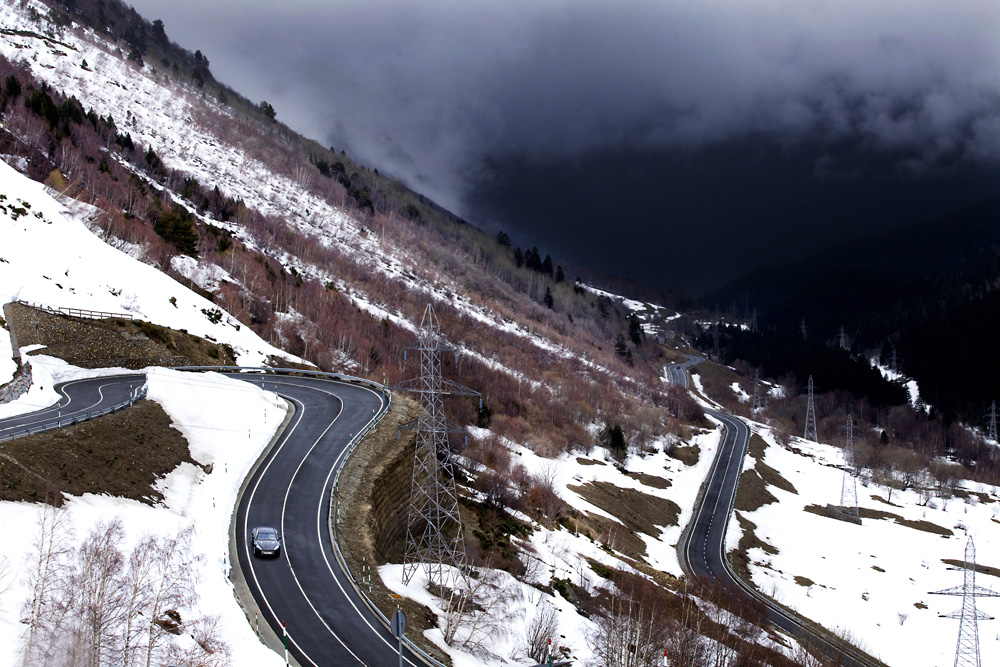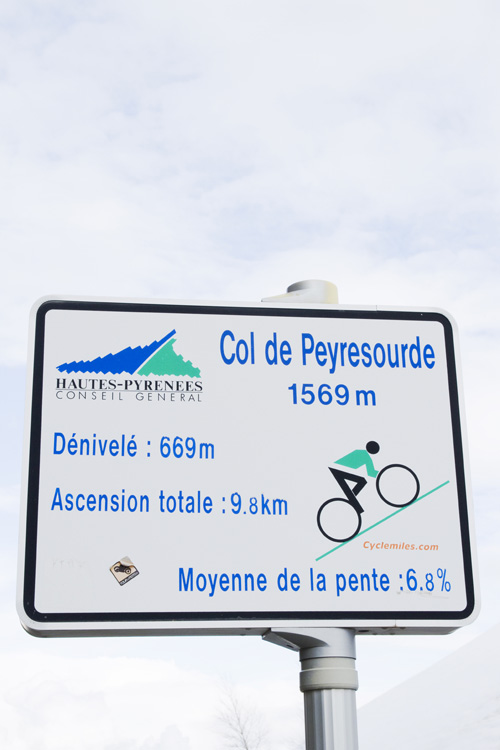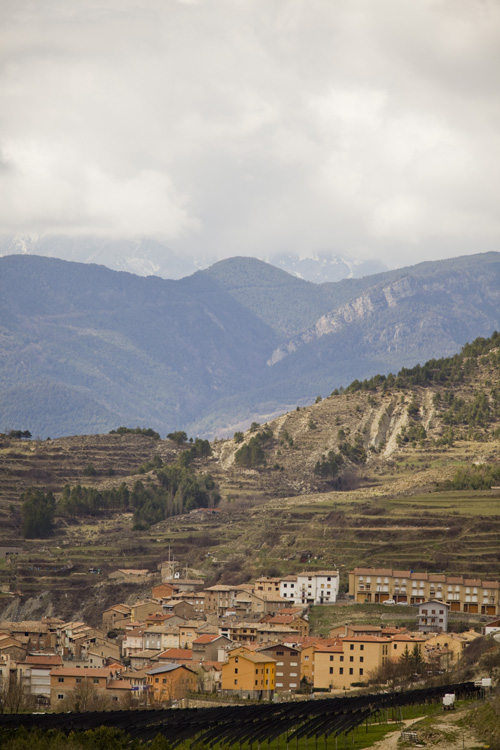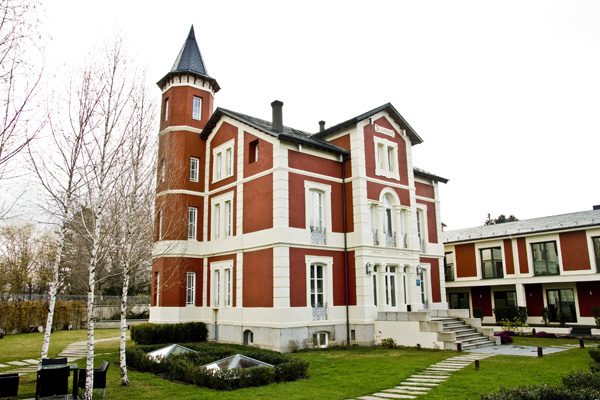Previous Article
Next Article
- AM WORLD
- FEATURES
- 100 YEARS OF ASTON MARTIN
- ARCHIVE
THE DRIVE

KING OF THE MOUNTAINS
Four wheels beats two as Kevin Hackett tackles one of the famous Tour de France climbs in the Pyrenees in the comfort and style of the new Rapide S
Photographs Kalpesh Lathigra

You are now entering Tour de France territory
Two pedals, motive power sent to the rear: the list of similarities between Aston Martin’s new Rapide S and a bicycle are, indeed, rather limited. A bicycle is still, after almost two centuries, the most basic form of mechanical transportation. Two wheels, a frame, a handlebar, seat, chain, sprockets and brakes—there isn’t much more to a bike. The Rapide S, on the other hand, is practically unrecognisable from the models that made Aston Martin world-famous in the middle part of the last century. Yet these two seemingly unrelated modes of transport have one thing in common right now: they’re both being used to tackle some of the most challenging roads in Europe.
The international media launch for the Rapide S has just ended. Dozens of journalists have visited the venue in Gerona, pored over every detail of the new model before driving it along some of the most spectacular routes Spain has to offer, and gone back to their respective countries deeply impressed by a model that takes the long-standing Rapide recipe of beauty, power and practicality, and adds performance, sharper handling and a raft of other subtle improvements to the mix. Our route is different, though. Our route is inspired by the battles fought on the roads that cross the nearby Pyrenees mountains, some over a century ago, by people on two wheels.

These hill climbs have pushed cyclists to the limits for over a century.
Aston Martins have always been ideal for epic road trips—they’re fast, comfortable and able to cover huge distances without their drivers becoming even slightly fatigued. They are also extremely glamorous, which only adds to the sense of excitement, adventure and accomplishment. Yet the route we will follow has been designed to test man and machine in a way I’ve never before experienced. And while I know full well that the Rapide S will take everything in its considerable stride, just looking at the way the roads to be tackled zigzag their way across huge swathes of map is enough to make me apprehensive. Imagine, though, having to make this trip on two wheels, open to the elements, with a seat the size of a postage stamp beneath your derrière.
We have two days to get from our Gerona base to the famous Col de Peyresourde stage of the Tour de France, itself the most famous cycling event in the world. The Tour, although predominantly staged in France, often crosses into neighbouring countries, and our destination is very close to the French/Spanish border, which is bisected by the jaw-dropping Pyrenees mountains.
Our chariot awaits. It easily swallows up enough camera gear and luggage for our trip, without the need to lower the Rapide S’s rear seats. Settled into position up front, it’s time to head off using the on-board satellite navigation system to guide us. As we gently cruise through the villages that surround our hotel, the car’s civility makes itself manifest. This is no temperamental supercar, rather a supremely easy-to-drive object of desire that pleases the local residents rather than upsets them with antisocial exhaust bellowing. People stop, stare, quickly take photographs with their mobile phones and, sometimes, wave and cheer us on. It feels good.
It’s hardly surprising that the Rapide S receives so much attention, though. The overall shape of the former Rapide remains, with only a gentle tweaking of the lines to grant the Rapide S more stability and visual harmony. The bold new radiator grille needs to be seen in the metal to be fully appreciated, too. Its increased aperture allows for better engine cooling, something we’ll no doubt need when climbing these vertiginous roads—but its visual appeal lies in the fact that it gives the Rapide S a more aggressive and assertive look. Changing what many viewed as a perfect shape is not for the fainthearted but Aston Martin’s Director of Design, Marek Reichman, and his team, obviously have the utmost respect for the company’s illustrious design history. When the Rapide S is described by its makers as the world’s most beautiful four-door sports car, it would appear everyone is in full agreement.

Left: four wheels definitely beats two on these roads. Right: hairpins don’t get much tighter than this
Soon we are climbing. Climbing through clouds, leaving behind the drizzle to be greeted by snow and lots of it. The Tour de France takes place in the summer months, when the surrounding hills, mountains and forests are as green as green gets. Now, however, we are blinded by a whiteout, with drifts three metres deep at the edges of the roads. Still, the Aston Martin makes short work of everything we throw at it and, as the road crisscrosses its way up and over mountains that the Norwegians would simply have tunnelled through, the adaptive damping comes into its own, perfectly adjusting the car’s stance through corners that in many cars you’d need to take at a walking pace. It’s on hairpin bends such as these that the Rapide S definitely earns its sports car stripes.
Even at five metres long, this glorious car manages to feel nimble and alert. Throwing it into the tightest of corners, it feels completely neutral (at least with the traction control left on), making for quick point-to-point driving and the steering is wonderfully precise, offering plenty of feed and information about what’s going on at the sharp end—crucial when roads are as variable as these. Braking, too, is strong and reassuring, although this car is fitted with steel discs rather than carbon ceramics, and they’re more than up to the job of bringing the Rapide S to a stop without fade, even after many hours of constant punishment.
The Rapide S’s two pedals get plenty of use but I only need to operate them with one foot—quite at odds with the cyclists we see pounding the same route. This is hallowed ground for them, possibly the two-wheeled equivalent of being able to push a classic car to its limits on the banking at Brooklands, and they seem completely unfazed by the ridiculously steep inclines being tackled. Could anything stand in their (or the Rapide S’s) way? It would appear so.

The smooth curves of the Rapide S complement those of the mountain roads
As we make our way to one of the many summits taken on this journey, a driver comes towards us flashing his headlamps and gesticulating wildly. This can mean a number of things when you’re driving one of the world’s most desirable cars: that there’s a police officer around the next corner, that there’s livestock running amok on the road ahead, or that our own headlamps are accidentally on full beam and said driver is being blinded by bi-xenons and LEDs. None of these apply in this instance, however, as it turns out the road ahead has been blocked by an avalanche. If we had been here just a couple of minutes earlier, there’s a very real chance this Rapide S could have become temporarily trapped in a very white, extremely cold and heavy tomb. A chill runs down our spines and it has nothing to do with the cold mountain air.
No matter how capable this Aston Martin is, though, there’s not a hope of it getting through this deadly obstacle. And when a snowplough does eventually arrive and set to work, literally bashing its way through to create a passageway, it’s the first time in two days that all eyes have been on something other than its sinewy curves. It’s been upstaged by a piece of industrial equipment but, with the road cleared, bystanders are again transfixed by the Rapide S’s superstar good looks.

Left: the snowplough clears the road after the avalanche, which our intrepid duo narrowly missed. Below left: the Rapide S glides through the narrow gap that has been created
The precipitous-looking snow is making creaking noises, meaning more could come tumbling down the mountainside at any moment, so we waste no time and get back on it, heading with as much pace as the conditions will allow for our ultimate destination.
Quite in keeping with its new S nomenclature, the Rapide S has more power, more torque and more rapidity The engine is still a 6.0-litre V12 but now puts out 558ps and 620Nm of torque, while the zero-to-60mph dash takes less than five seconds. And this little snippet is crucial, as its breadth of abilities, while not dramatically different from the original model, are now enough to allow the Rapide S to shine on paper as well as on tarmac.
Wind and road noise are noticeable by their absence, even with tough compound winter tyres fitted, and that’s largely down to the double-laminate glass. In keeping with the Rapide S’s grand touring nature, the incredible sounds produced by its masterpiece of an engine don’t dominate the cabin, but that doesn’t mean you can’t enjoy its war cry when the opportunity allows. Because our route is peppered by occasional, extremely long tunnels.

The mountain tunnels provide an opportunity for the Rapide S to let out a throaty roar
Approaching the mouths of these subterranean highways, keep the speed down and lower both front windows. Once the road ahead is clear, override the automatic transmission by tugging on the manual paddles and floor the throttle. The Aston Martin powers forward with alarming pace, holding onto each ratio until it either hits the limiter or you change up through the box, and the indescribable crescendo bounces back from the rock face just a few metres above the car’s roof and into your appreciative ears. It’s a guilty pleasure, a satisfying noise that could cause an avalanche of its own, and serves to highlight the Rapide S’s dual nature. Comfortable cross-continent express or full-on sports car—both of these opposites are catered for with this wonderful car. The engine is mounted farther down in the chassis than before, giving a lower centre of gravity, meaning that the Rapide S is secure and planted, no matter how twisty these roads are. The bonded aluminium structure that borrows much from aerospace technology remains resolutely stiff and free from flex, where some other cars of this size would feel as bendy as the roads being navigated. It’s a sports car, pure and simple, that just happens to have four doors, four usable seats and a hatchback.

Spectacular views across the valley to the town of Olot
After two solid days of hard charging, we eventually start seeing signs for Col de Peyresourde and, peeling off the D125 main road onto the D618, we once again start climbing, passing the Lycra-clad cyclists who evidently possess more strength, energy and sheer determination than us. The Rapide S makes mincemeat of the road and, even as we near the top, taking in some ridiculously tight hairpins, it powers on relentlessly. Arriving at the summit, we climb out feeling as fresh as the minute we climbed in.
Expecting this place to be a haven for cycling enthusiasts reliving some of the Tour de France’s past battles and victories, we’re surprised to find a bustling ski resort. Visitors from all over Europe are busy making the best of the last of the snow and there isn’t a bicycle in sight. No shops selling Tour de France memorabilia, no yellow jerseys to be seen anywhere. Just the odd bit of graffiti painted onto the tarmac and a small road sign telling us we’ve reached the finishing line. But then, that’s the beauty of a road trip—you never really know what you’ll discover at the end of it. Only, this isn’t the end for us. We have to get the Rapide S back to base before returning home, and that means many long hours of driving cross-country in the pitch dark. But this car once again proves its worth as one of the world’s truly great sports GTs, safely putting down its prodigious power on slippery, narrow and twisting unlit roads. Four hours later and we arrive, spent, at our hotel for the night, the Villa Paulita in the heart of Spain’s charming Puigcerdà, capital of the Cerdanya region that’s barely a stone’s throw from the border with France.

Villa Paulita in Puigcerdá combines glamour with sophistication
Designed and built as a family residence in the early 20th century by industrialist Ramon Volart, and named after his wife, Paulita, it was only recently converted into a hotel and is still in the hands of the family that built it. Slightly off the beaten path, it is, however, worth seeking out by weary travellers and the gastronomic restaurant, L’Estany, serves the finest dishes in the region. It reeks of history yet looks to the future and smacks of glamour and sophistication, just like the company that builds the car we arrive in.
The Aston Martin remains rare and desirable, marking out its fortunate owner as someone with individuality and taste. Having covered almost 1,000 miles in this one over two days, we couldn’t have wished for anything else and, if you need two pedals and rear-driven wheels to travel through this wonderful part of Europe, neither could you.
Hotel Villa Paulita
Avienda Pons i Gasch, 15,17520, Puigcerdà
Tel: +34 972 88 46 22
www.villapaulitahotel.com
Previous Article
Next Article
- AM WORLD
- FEATURES
- 100 YEARS OF ASTON MARTIN
- ARCHIVE
